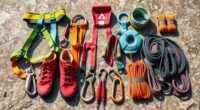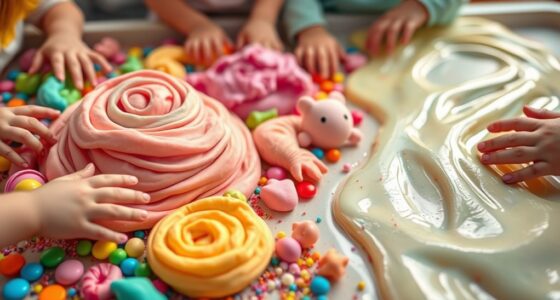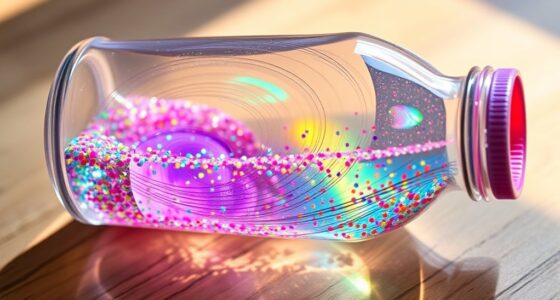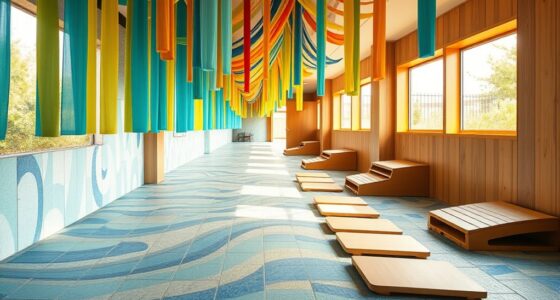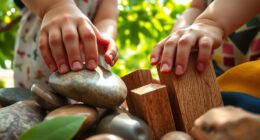If you’re looking for fun, homemade alternatives to kinetic sand, try mixing cornstarch and water to create a non-Newtonian fluid that feels similar. You can also combine flour and oil for a moldable, sand-like texture, or use dried beans and lentils for a tactile sensory experience. Adding food coloring or scents makes it more engaging. Keep exploring these simple options to find the one that suits your sensory play needs best.
Key Takeaways
- Create homemade slime with glue, borax, or saline solution for a stretchable, kinetic-like sensory experience.
- Mix cornstarch and water to form a non-Newtonian fluid that mimics kinetic sand’s texture.
- Use homemade doughs or putty made from household ingredients for moldable, tactile play.
- Incorporate natural materials like dried lentils, beans, or sand into sensory bins for natural textured alternatives.
- Combine edible substances like pudding or whipped cream for safe, squishy sensory activities similar to kinetic sand.

If you’re looking for fun and tactile play options beyond traditional kinetic sand, there are plenty of alternatives that can provide similar sensory experiences. One of the most versatile and popular options is DIY slime recipes. Making slime at home allows you to customize textures, colors, and even add glitter or small toys for extra engagement. With simple ingredients like glue, borax or saline solution, and food coloring, you can create a gooey, stretchable substance that’s perfect for sensory play ideas. The process of mixing, kneading, and shaping slime stimulates fine motor skills and keeps children engaged for hours. Plus, it’s easy to clean up, making it an excellent choice for indoor activities.
DIY slime offers customizable textures and endless sensory fun for kids indoors.
Beyond slime, there are other DIY options you can explore that offer tactile fun. For example, homemade putty or doughs made from common household ingredients can mimic the feel of kinetic sand. You might try mixing cornstarch and water for a non-Newtonian fluid that’s both mess-free and fascinating to touch. This type of sensory play encourages experimentation with textures—sometimes firm, sometimes squishy—and enhances sensory processing. Adding scents or colors to these mixtures can make the experience even more engaging and personalized.
If you want to expand your sensory play ideas, consider making edible or safe-to-handle materials. For instance, whipped cream or pudding can simulate soft, moldable textures, and are safe for children to explore closely. These edible options can be especially useful for younger kids who love to squish and manipulate their play materials without concern for mess or safety. You could also try making rice or pasta sensory bins, where the dry grains or noodles provide a different tactile sensation, or add essential oils to introduce calming scents.
Another creative idea involves using natural materials such as dried lentils, beans, or sand collected from outside, which can be combined with homemade play dough or slime bases. These natural sensory play ideas encourage outdoor exploration and connect children with nature while still offering tactile stimulation. The key is to keep things simple and safe while encouraging kids to explore different textures and develop their sensory skills.
Frequently Asked Questions
Are Homemade Kinetic Sand Substitutes Safe for Children?
Homemade kinetic sand substitutes can be safe for children if you choose ingredients with safety in mind. Use non-toxic, food-grade items like cornstarch, flour, or rice, and avoid chemicals or harsh additives. Consider the environmental impact by opting for biodegradable and natural ingredients. Always supervise playtime and test small amounts first to guarantee safety, preventing any allergic reactions or choking hazards. Your careful choices help keep play both fun and safe.
How Long Do Homemade Kinetic Sand Alternatives Last?
Your homemade kinetic sand alternatives typically last about 1 to 2 weeks, depending on storage conditions. To extend shelf life, keep them in an airtight container and avoid excess moisture. Mold prevention is essential; if you notice any mold or a sour smell, discard the mixture immediately. Proper storage and regular checks help guarantee your DIY sand stays safe and fun to play with longer.
Can I Color Homemade Kinetic Sand Easily?
Yes, you can easily color your homemade kinetic sand using DIY dyeing techniques. Simply add a few drops of food coloring or liquid watercolor during the mixing process, and use color mixing to achieve your desired shade. Knead the sand thoroughly to evenly distribute the color, and add more dye if needed. This method makes customizing your homemade kinetic sand fun and simple, giving you vibrant, personalized results every time.
What Is the Best Storage Method for Homemade Alternatives?
You should store your homemade sand alternatives in airtight containers to keep them fresh and prevent drying out. Make sure the containers are sealed tightly after each use to maintain moisture control, which helps keep the texture consistent. Avoid exposing your mixture to direct sunlight or humidity, as these can affect its quality. Using airtight containers guarantees your DIY sand stays soft, pliable, and ready for play whenever you need it.
Are There Any Allergen Concerns With DIY Kinetic Sand?
Are allergen concerns creeping into your DIY kinetic sand? You should absolutely check for allergenic ingredients like certain oils, dyes, or glitters that might trigger allergies. It’s wise to conduct allergy testing on a small patch of skin first, especially if you or your kids have known sensitivities. Staying cautious helps you avoid uncomfortable reactions, giving you peace of mind while enjoying your homemade, hypoallergenic sand.
Conclusion
So, now you’ve got plenty of DIY options to replace kinetic sand—who knew making your own could be so fun? Ironically, the simplest ingredients often give you the best playtime. So go ahead, get your hands dirty with these homemade alternatives. After all, who needs store-bought kinetic sand when you can craft your own, messier, and maybe even more entertaining version? Happy playing—your new favorite sandbox is just a few ingredients away!


